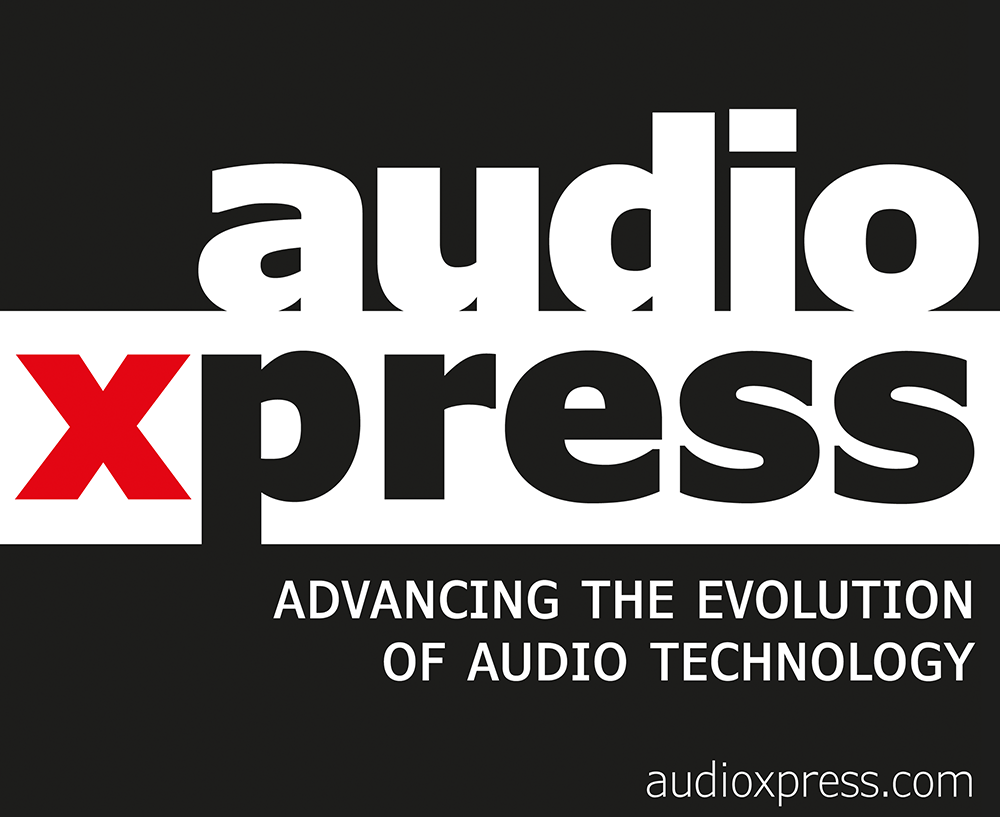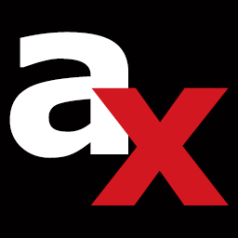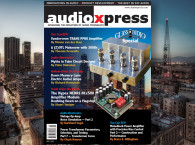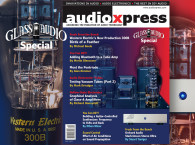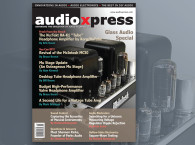 This traditional annual Glass Audio special issue of audioXpress offers a great combination of audio electronics and DIY tube projects, not forgetting speakers, music experiences, and more.
This traditional annual Glass Audio special issue of audioXpress offers a great combination of audio electronics and DIY tube projects, not forgetting speakers, music experiences, and more.And there is no better way to start than with the exploration of different music experiences. As Michael Harkins received an unexpected gift, a recently pressed 78 rpm album with original live-recorded music, he felt the urge to explore why the format was chosen and if there are reasons to consider its return. As he found, a label from Virginia is releasing original music in 78 rpm 12-inch vinyl records, returning to a standard that dominated before the 50s. More pressing plants are actually advertising the possibility of releasing 78 rpm records, but do they work to any advantage with modern turntables and using the available cartridges? All those questions are explored in this fascinating article.
And on to the Glass Audio content, we start with the expertise of Rudolf Moers, describing his Ultra-Linear Power Amplifier, that he characterizes as an adventure between triode and pentode. As Moers explains, in 1951, David Hafler and Herbert Keroes introduced a pentode power amplifier in which a tap of the primary transformer winding was connected to the screen grid of the power pentode. Fascinated by the far-ranging effects of such a seemingly simple change, this project expands on the investigation of possible results.

Next up, in Getting Less Gain from Tubes, Merlin Blencowe explains how getting small amounts of voltage gain in tube circuits is worth exploring. The useful concept yields interesting results, such as the possibility of reducing tube gain without compromising the sound signature of our favorite stage. While the subject matter isn’t entirely original, it’s rarely discussed explicitly in circuit design books.
And continuing with more Audio Electronics with Tubes, Hans Polak stumbled upon some reports on the loss of micro details due to a collapse of permeability in output transformers at low levels. Being of an inquiring nature, the author decided to have a detailed look. His article titled Micro Details in Push-Pull Output Transformers documents his findings.
Transitioning to a more practical approach, Alan Kimmel wanted to share with our readers what he believes to be a breakthrough of his original Mu Stage designs. Calling it a Type 3 Mu Stage, this is the latest iteration on a long experimentation process, spanning more than three decades. The original Mu Stage project was in fact published in Glass Audio in 1993, and remains a popular build, serving the author's purpose to "combat listener fatigue." Even though his Type 2 Mu Stage, published by audioXpress in 2019, introduced a streamlined version with added capabilities, the new Type 3 Mu Stage resulted in what the author believes to be a breakthrough, improving the realistic reproduction of music.
To independently assess his own beliefs and impressions, Alan Kimmel asked Kim Bond, an enthusiastic builder of his previous Mu Stages, to prototype the new Mu3 Stage. As Kim Bond shares, “...my first Mu Stage was an immediate success, and I used it as the combined voltage amplifier/driver stage for a series of single-ended power amps. Over the years, I used Mu Stages elsewhere, including in phono stages, so when Alan asked if I would prototype the Mu3, all I could say was YES!

And expanding the DIY approach to a different field, expert speaker builder Ben (Wolf) Shaffer shares with audioXpress all the details of his Anomalies V2 speaker design. Calling the process “Leaving the Trodden Speaker Path,” this DIY project uses an appealing combination of Wavecor and SB Acoustics drivers in a very unusual cabinet design and method - hence the designation of “Anomalies.” The V2 iteration, a two-way with a Double Bass Reflex cabinet alignment using passive radiators, was presented at the annual InDIYana event, and this article offers the first complete description of the concept.
And on to another speaker DIY project, Ken Bird shares all the construction details of the Coffee Can Towers. Having previously built a successful 2.1 speaker system using coffee cans (audioXpress, October 2020), has inspired the creation of a more ambitious follow-up project. Consisting of five individual can enclosures per tower, this three-way design was an interesting challenge, even for an experienced speaker builder such as Ken Bird. The results look deceptively simple, but only an experienced builder such as Ken Bird could pull this off and make the result look as great as it does.

And in this May 2025 issue of audioXpress, Paul Marchese concludes his Primer on Class-D Amplifiers with Part 2 - A Practical Implementation. The successful design of high-performance Class-D amplifiers requires a sound understanding of the basic concepts, which are unfamiliar to audio designers and that this detailed article addresses. In Part 1 of this article, the author focused on a theoretical review of the Class-D concept, while this second article discusses an actual build using a familiar Texas Instruments TPA3255 integrated amplifier as a reference.
And there is no better way to conclude this Glass Audio special than with Richard Honeycutt explaining how he learned to Do It Yourself with Tubes in his regular Hollow State Electronics column. Reflecting on his own journey, Richard Honeycutt emphasizes the importance of practical experience and accessible resources for aspiring audio electronics enthusiasts. In this article, he shares some of the readings and published books that have helped him in his journey as an audio electronics and speaker builder enthusiast.

All great reasons to not delay and download now this May issue. Please remember that all the content contained in every issue of audioXpress is the reason this publication continues to reinforce its role as an essential resource for the audio industry, month after month, 12 times per year. Your support and that of our advertisers is what allows us to keep this publication in print and on all the digital platforms as well as pay our independent authors and contributors for their work.
Subscribe if you haven't done so in order not to miss future issues or renew your subscription. Subscribing to the digital online version allows immediate access and is available here: audioXpress Subscription Services
If you wish to buy a single printed issue or the complete audioXpress archive on USB, from 2000 to 2025 (yes, including the latest issue), just visit our online shop at www.cc-webshop.com.
And check out the new options to access the audioXpress Digital archive:
https://simplecirc.com/subscribe/audioxpress
Don't miss out, get your copy of audioXpress right now at www.gotomyxpress.com
